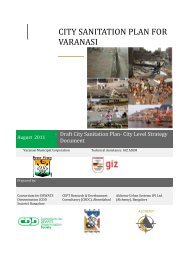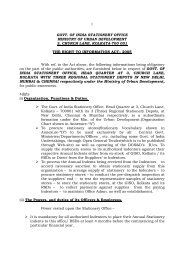CITY SANITATION PLAN - Ministry of Urban Development
CITY SANITATION PLAN - Ministry of Urban Development
CITY SANITATION PLAN - Ministry of Urban Development
Create successful ePaper yourself
Turn your PDF publications into a flip-book with our unique Google optimized e-Paper software.
<strong>CITY</strong> <strong>SANITATION</strong> <strong>PLAN</strong> BAREILLY<br />
7. 50% <strong>of</strong> the available community toilets are in bad state. The infrastructure facilities in these<br />
toilets are almost broken conditions but even then, the people are still dependent upon<br />
these community toilets.<br />
8. About 6% <strong>of</strong> the community toilets are not in a usable state<br />
9. About 30% <strong>of</strong> the communities toilets are equipped with pour flush pit latrines and about<br />
37% <strong>of</strong> them with water closets. There are also about 17% <strong>of</strong> the community toilets with dry<br />
pit latrine and the rest with service and unimproved pit latrines.<br />
10. About 32% <strong>of</strong> the community toilet facilities are connected to septic tanks and about 50% <strong>of</strong><br />
them are connected to sewer lines.<br />
11. In about 80% <strong>of</strong> the community toilets with septic tanks, the fecal sludge collected from<br />
these septic tanks by the municipalities or private sludge sucking machine and they dispose<br />
it into nearby nalas which lead to Ganga River.<br />
12. In addition to the disposal <strong>of</strong> sludge produced at community toilets there are also about 10%<br />
<strong>of</strong> the community toilets using the sludge at bio gas treatment.<br />
13. There is about 98% <strong>of</strong> the community toilets have no proper effluent waste management.<br />
There are all let into open drains. There is only about 2% <strong>of</strong> the number <strong>of</strong> community toilets<br />
effluent waste disposed/ connected to sewer lines.<br />
Key Issues <strong>of</strong> Fecal Sludge Management:<br />
FS management component<br />
and aspect<br />
Emptying + collection<br />
Technical<br />
-Limited or no<br />
accessibility to pits<br />
-Inappropriate<br />
emptying equipment<br />
-Manual, nonmechanized<br />
emptying<br />
Institutional/Financial -Poor<br />
management<br />
service<br />
-Users. low<br />
affordability for pit<br />
emptying<br />
-Lack <strong>of</strong> information<br />
(e.g. on how septic<br />
Causes Problems Consequences<br />
- Overflowing pits<br />
_ Emptying<br />
frequency <strong>of</strong>ten<br />
very low<br />
_ Informal or<br />
emergency<br />
emptying <strong>of</strong><br />
pits and<br />
indiscriminate<br />
disposal <strong>of</strong> FS<br />
At neighbourhood<br />
level, mainly<br />
--Health hazards<br />
from openly<br />
dumped FS and<br />
through use <strong>of</strong><br />
contaminated water<br />
_ Eye and nose<br />
sores<br />
_ Non-functionality<br />
<strong>of</strong> infrequently<br />
emptied septic<br />
tanks-solids carryover<br />
ADMINISTRATIVE STAFF COLLEGE OF INDIA, HYDERABAD Page 83
















